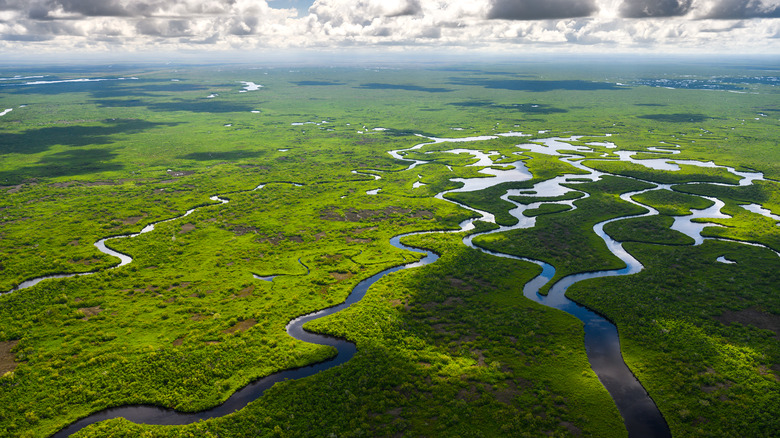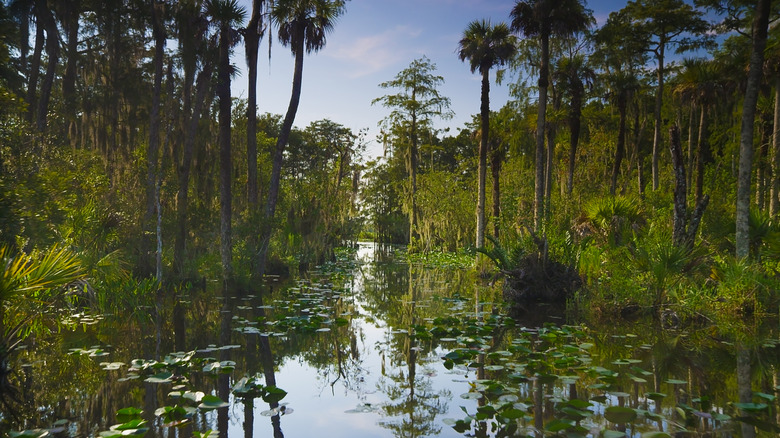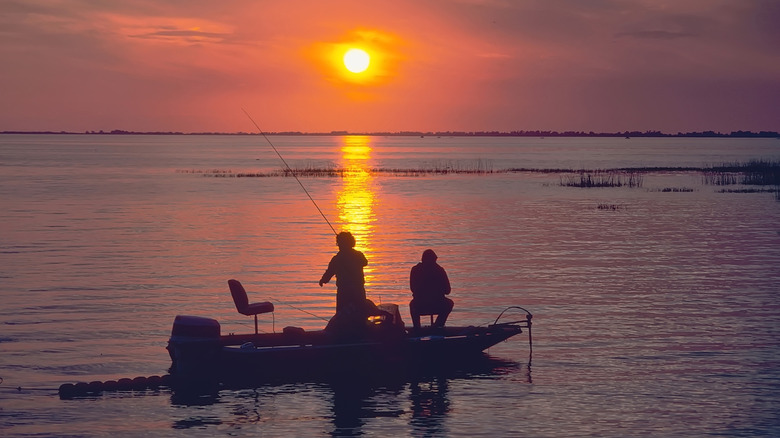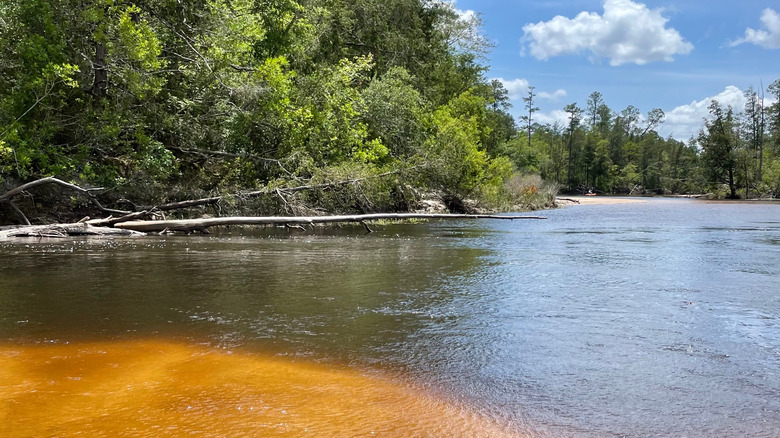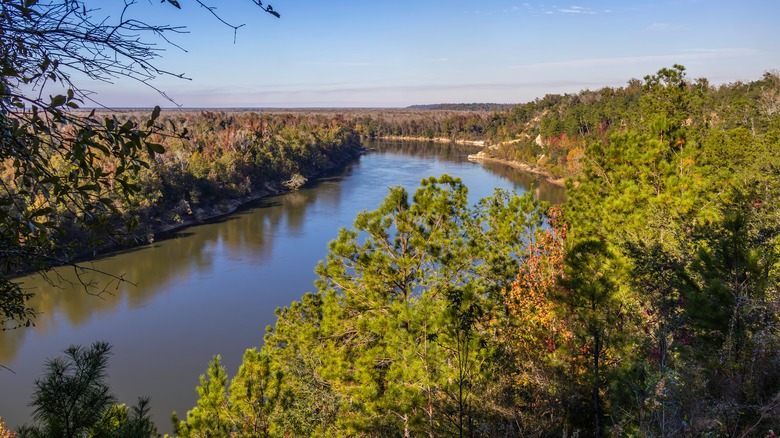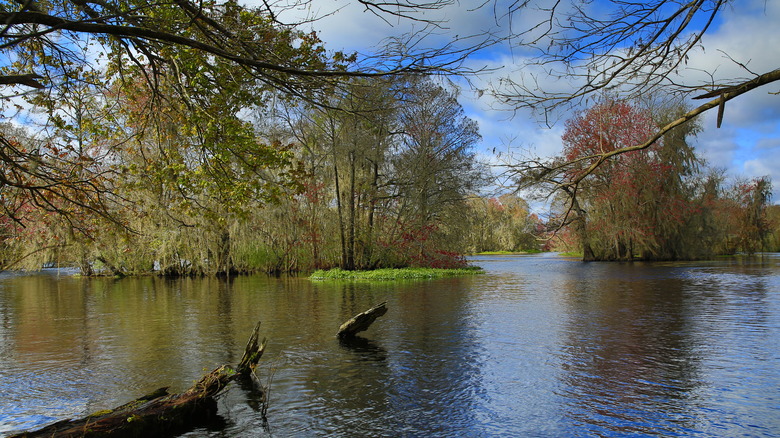Florida's Most Snake-Packed Waters Aren't For The Faint Of Heart
As if alligators, crocodiles, airboats in the Everglades, and Instagram fishing models weren't enough, visitors to Florida can add one more water-related species to watch out for: snakes. Lots and lots of snakes. As the Department of Wildlife and Conservation points out, Florida is home to a full 46 species of snakes. And while final numbers of snakes are hard to come by (they tend to slither out of sight, after all), six of those species are venomous: timber rattlesnakes, copperheads, Eastern diamondback rattlesnakes, water moccasins (aka cottonmouths), pygmy rattlesnakes, and coral snakes. These snakes and others live in habitats ranging from dry to wet –– from remote marshes to your backyard. They also live in and around the state's waters, although some waters are more snake-packed than others.
Visitors to Florida's waters could encounter snakes around a body of water or in the water, itself. Semiaquatic snakes like water moccasins, for instance, spend part of their lives in the water, part on land, and are pervasive across Florida. While you easily disturb a snake while having a picnic around the shore of a lake, you definitely don't want to brush up against one while swimming. Some national parks in Florida like the Everglades completely prohibit swimming, while state parks allow swimming in specific areas, only. This means that visitors looking to head to Florida's waters should exercise caution while diving into outdoor fun, whether water-based or otherwise. This is especially true near bodies of water that are particularly snake-infested, like Blackwater River, Big Cypress National Preserve, Apalachicola River, Withlacoochee River, and Lake Okeechobee.
Big Cypress National Preserve is a swampy snake haven
Adjacent to Everglades National Park towards the southern tip of Florida, Big Cypress National Preserve is an unusual entry in our list because, if you look at it from a Google's-eye perspective, you won't see typical bodies of water like big lakes and rivers. That's because vast swaths of the entire, mammoth, 729,000-acre preserve is swampland, marshes, and estuaries. It's like the wild heart of Florida before retirees ever thought of heading to West Palm Beach, Miami, or any of the other beaches towns to the east.
Alligators love Big Cypress National Preserve, and so do snakes. Visitors to the preserve will find some of the same snakes that they'd find across the rest of Florida, like the greenish-brown Florida green watersnake, the red-and-black (but harmless) Eastern mudsnake, and the dangerous water moccasin, a pit viper.
While you can certainly hike or bike along some sandy Big Cypress National Preserve trails, like Fire Prairie Trail or Burns Lake South Trail, much of the enjoyment of the park comes from wading or boating through its waters. Big Cypress National Preserve is ideal for rough, messy, and wet activities trudging through waist-high water during Florida's rainy season (May to October), off-roading through that same water in swamp buggies, or paddling through three-to-four-hour-long canoeing trails. All of these activities could put you face-to-face with any number of snakes. So could doing a backstroke through waist-high water in your wading pants and wading boots, which we don't recommend. But, at least the whole place is free, unlike its much-discussed neighbor, Everglades National Park.
Lake Okeechobee has venemous snakes and even pythons
Folks might have noticed that the Floridian landmass has a big, blue hole in it surface, west of West Palm Beach. That body of water, Lake Okeechobee, is the third-largest lake in the entire country, discounting Great Lakes that extend into Canada. It's 730 square miles in surface area, 135 miles in circumference, and of course, is home to various snake species. This includes the non-venomous banded water snake and the venomous water moccasin. Terrifyingly, it's also home to an invasive snake species originally imported to the U.S. as pets, the Burmese python. You know, the guys that wrap around their prey and swallow them whole. They weigh up to 200 pounds, reach up to 23 feet in length, and can stay underwater for 30 minutes without breathing.
In case that isn't a ringing endorsement for setting out onto Lake Okeechobee's vast waters, the freshwater lake is dubbed the "bass capital of the world," although its fishing options extend to catfish, bluegill, and crappie, too. Folks heading out on the lake can also engage in some birdwatching, alligator watching, or a general scenic tour of the environment. And speaking of alligators, over 30,000 of them live in the lake — that's more than any other single body of water in Florida. So, given the vast quantities of alligators, some pythons, other venomous snakes, as well as a whole lot of pollution and toxic blue-green algae, it is not recommended that anyone swims in Lake Okeechobee (though some people still take that risk). You can, however, stick around the campgrounds around the lake's perimeter, but then again, you should still keep an eye out for snakes there, too.
Blackwater River and its state park are home to a host of snake species
Next we come to a state park about as far from Florida's southern tip as possible, northwest in the panhandle all the way near Alabama. There, the serpentine and narrow Blackwater River winds out towards Blackwater Bay, East Bay, and the Gulf beyond. This river provides another hotspot for several types of everyone's favorite, legless reptile. Midland watersnakes, ribbon snakes, and ring-necked snakes all call it home. Thankfully, none of them are venomous. The mire of the adjacent Blackwater River State Park, however — with waters so shallow that you can see the sandy bottom — contains non-venomous black swampsnakes and very venomous water moccasins.
If folks stick just to Blackwater River, it's likely that they'll paddle down its length or do some fishing in areas where the water moves extra slowly (it usually moves 2 to 3 miles per hour). Folks could also very meanderingly potter down the river in a tube. But since Blackwater River passes through the park of the same name, it's likely that plans would involve both, especially since the 636-acre park is so small and inviting. Blackwater River State Park has a few modest hiking trails, like the half-mile Juniper Lake Loop Trail, and 30 camping sites for tents and RVs, each one with electric and water hookups and its own table and grill. But most pointedly for snakes, it also allows swimming from one of its two pavilions. Hike, camp, and especially swim at your own risk.
Several venemous snakes live along the Apalachicola River and in its parks
The Apalachicola River cuts right across the entirety of the Florida panhandle west of Tallahassee, north to south, and empties into a bay of its own name, Apalachicola Bay. The 106-mile-long river not only plays a critical economic role in Florida and across the U.S., supplying water to $5.8 billion in fisheries along the gulf and yielding 10% of the U.S.' oyster supply, but a critical ecological role. Amongst the thousands of collective plant, amphibian, mammal, fish, and reptile species that it supports, it's fish the tell its snake-filled tale. More fish call Apalachicola River home than any other river in Florida, which means that semiaquatic snakes love it as a feeding ground. Most importantly for safety, this includes two venomous species: timber rattlesnakes and copperheads.
Much like Blackwater River, Apalachicola River runs along a number of parks and nature preserves, like the hiker's paradise of Torreya State Park, Apalachicola National Forest, and the Apalachicola River Wildlife and Environmental Area. Apalachicola River allows boating and fishing along its length and camping and hunting along its edges, much like the Apalachicola River Wildlife and Environmental Area. Apalachicola National Forest, meanwhile, offers plenty of camping and hiking on land and canoeing and kayaking in the water. Visitors can also swim at Camel Lake Recreation Area. The forest is also home to even more snakes, like the eastern diamondback rattlesnake (venomous), timber rattlesnake (venomous), and black racer (non-venomous). All this is to say: If you set out along the Apalachicola River or into its surrounding natural areas, especially the Camel Lake Recreation Area, take care where you step or swim.
The Withlacoochee River plays hosts to plenty of snakes
The whole chunk of Florida west of Orlando and north of Tampa is full of Withlacoochee-related sites, including streets, trails, electric plants, and RV parks. Withlacoochee River dominates west-central Florida in part because the river is 157 miles long and passes through five counties. And though the lower river originates in Green Swamp in Hernando County northeast of Lakeland, the Withlacoochie is also fed by Madison Blue Spring way near Florida's borders in the north. In other words: Lots of snakes live there, if only because of the river's size. Amidst its rising and lowering alluvial waters slink snakes species like the non-venomous scarlet kingsnake and brown water snake. It's also home to our old friend that keeps popping up again and again, the venomous water moccasin.
Withlacoochee River and its waters connect to a number of parks, notably Withlacoochee River Park, Withlacoochee State Forest, and Withlacoochee Gulf Preserve. That means plenty of things to do and just as many opportunities to come across snakes. The overlooked Withlacoochee State Forest is an expansive, eclectic ecosystem with a host of clustered areas for horseback riding, hiking, biking, fishing, paddling, camping — basically everything you could want out of a watery Floridian park. The much smaller, 758-acre Withlacoochee Gulf Preserve is a prime marshland hiking spot for spotting birds, and the even smaller, 406-acre Withlacoochee River Park has an RV park and observation tower. And if we extend the reach of Withlacoochee River to Madison Blue Spring, one of its origins, then that state park houses a well-known, 25-foot-deep swimming spot voted the number one swimming hole in the U.S. by USA Today. But even though they don't mention snakes, watch out.
